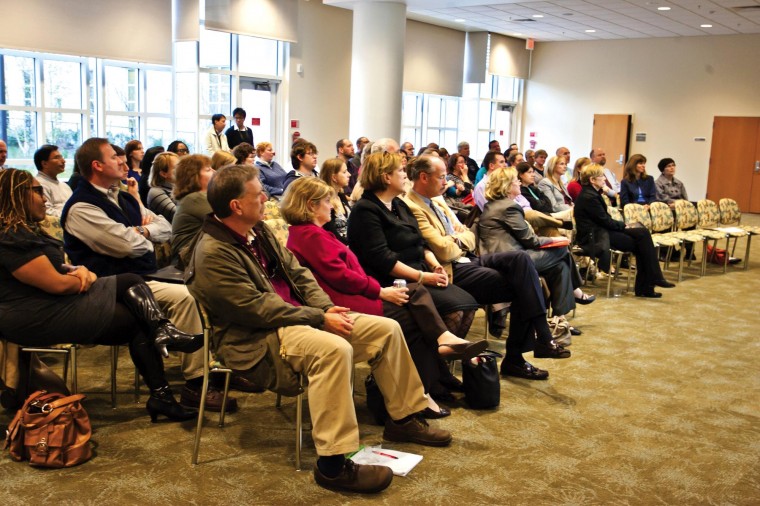
A crowd of university officials and students listen to a presentation in Oakland Hall yesterday on the future of on-campus housing, as detailed in a new report.
Although Resident Life was able to house a record number of students on the campus this fall, officials need to focus their efforts on several key issues to improve housing at this university, according to a study released yesterday.
Since January, a six-person committee comprised of university officials worked to compile a 250-page report detailing housing needs at this university. Yesterday afternoon, the team told a group of dozens of high-ranking university officials and several student leaders that the Department of Resident Life needs to add more housing options for graduate and transfer students, more single bedrooms and more “appealing features,” such as air conditioning and laundry machines, to all on-campus housing facilities.
Last spring, officials said a housing crunch — which prohibited many juniors and seniors from living on-campus — was over, and now Resident Life officials are turning their heads toward the future of on-campus living.
“[This study] is going to be the basis of a comprehensive strategic plan to determine where we will go in the future,” said Assistant Vice President for Student Affairs Mary L. Hummel, who served on the study’s committee. To compile the report — which officials from the consulting firm Anderson Strickler presented — seven focus groups were held last semester for students to attend, and online surveys were sent to students and parents. The six-person team received 2,842 student responses and 2,459 parent responses, according to PowerPoint slides at yesterday’s presentation held in Oakland Hall’s Multipurpose Room.
One issue the report focused on was providing all students — from freshmen and seniors to transfer and graduate students — with housing. Although the university has added 5,000 beds since 2006, there is still a shortage of available, affordable housing for graduate and transfer students, the report stated. Currently, there are only 476 beds allotted for graduate students, who pay almost $200 more per semester for an apartment with single bedrooms, according to the study.
“It’s a hard thing for incoming [graduate] students who want to come here,” said graduate student Adil Yalcin. “I had to search for [housing] months before I came here.”
Additionally, the study found the demand for different types of on-campus housing does not reflect the current options. Almost 4,000 responses, allowing for overlap, indicated students would rather live in a single bedroom, either in a dorm or in an apartment. A similar number said, if given the choice, students would rather not live in a standard double room.
“Given an average circumstance, I would prefer a single,” said freshman computer engineering major Zehao Sui. “It would give me more concentration and more privacy.”
Students also responded to the survey with a list of “appealing features” they would like to ensure all dorms had, such as a 24-hour service desk, security cameras, quiet study areas and good Wi-Fi access.
Because some dorms, such as the newly-opened Oakland Hall, are more luxurious than their older counterparts, the study also recommended the department review the “one price” policy. Students living in dorms pay the same amount, regardless of how old or how many amenities — excluding in-room kitchen facilities — their building has.
Several students, like sophomore computer engineering major Chris Luo, said while he understands dorm placement is based on a lottery system, it might be more fair if different dorms had varying prices.
While no clear future steps were provided, officials said they will take the results into account as they look to improve student housing in the coming years.
“I didn’t find too many surprises,” said Resident Life Director Deb Grandner. “The survey is part of a master planning process, and we will work in the next six months to develop a long-term housing plan to identify all these issues.”
israel@umdbk.com



